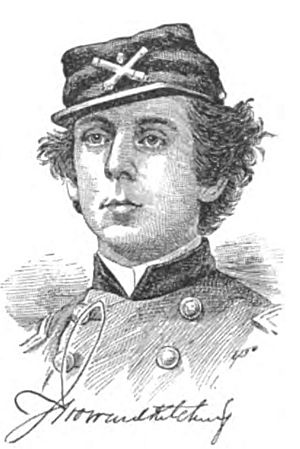J. Howard Kitching facts for kids
Quick facts for kids
J. Howard Kitching
|
|
|---|---|

Sketch after his death
|
|
| Born | July 16, 1838 New York City, US |
| Died | January 11, 1865 (aged 26) Dobbs Ferry, New York, US |
| Buried |
Green-Wood Cemetery, Brooklyn, New York
|
| Allegiance | United States Union |
| Service/ |
United States Army Union Army |
| Years of service | 1861–1864 |
| Rank | |
| Unit | 2nd New York Artillery |
| Commands held | 6th New York Heavy Artillery Kitching's Heavy Artillery Brigade |
| Battles/wars | American Civil War |
| Spouse(s) | Harriet Brittan Ripley |
| Other work | merchant |
John Howard Kitching (born July 16, 1838 – died January 10, 1865) was an important officer. He fought for the Union Army during the American Civil War. He served in different parts of the army. These included the cavalry, artillery, and infantry. He was part of the Army of the Potomac and the Army of the Shenandoah. After he was badly wounded at the Battle of Cedar Creek, he was given a special promotion. This promotion made him a brevet brigadier general.
Contents
Early Life and Family
John Howard Kitching was born in New York City on July 16, 1838. His father, John Benjamin Kitching, was a merchant. His mother was Maria Bradner. John's father was born in England. He was one of the first people to invest in new technologies. These included ships designed by John Ericsson. He also invested in the telegraph and the transatlantic telegraph cable.
Kitching married Harriet Brittan Ripley on July 18, 1860. They had two children together. Their son, John Howard Kitching, Jr., was born in 1861. Their daughter, Edith Howard Kitching, was born in 1864.
Military Service in the Civil War
When the Civil War began, Kitching volunteered for the New York cavalry. Soon after, he became a captain in the 2nd New York Artillery. In September 1862, he became a lieutenant colonel. This was for the 135th New York Infantry. This unit was later renamed the 6th New York Heavy Artillery. It was also known as the Anthony Wayne Guard.
For much of the war, Kitching's unit was on guard duty. They were stationed along the upper Potomac River. The colonel of his regiment, William H. Morris, was promoted in November 1862. Kitching then became a colonel on April 26, 1863. His regiment joined the Army of the Potomac. This happened after the Battle of Gettysburg. During late 1863 and early 1864, Kitching briefly commanded the army's ammunition and artillery supplies.
Overland Campaign Battles
At the Battle of the Wilderness, Kitching led a heavy artillery brigade. This brigade was part of the Army of the Potomac's artillery reserve. After this battle, the artillery reserve was split up. Kitching's brigade was then assigned to the V Corps. They fought with this corps at the Battle of Spotsylvania.
Kitching's artillery brigade was later changed to an infantry unit. They fought as infantry at the Battle of Cold Harbor. They also fought at the Second Battle of Petersburg. Kitching and the 6th New York Heavy Artillery were then moved. They went to help defend Washington, D.C. There, he took part in the Battle of Fort Stevens. After this battle, he commanded a brigade in the Washington defenses.
Shenandoah Valley Campaign
During Philip H. Sheridan's Valley Campaign, Kitching's command was moved. It joined the Army of the Shenandoah. Other units were added, and it became Kitching's Provisional Division. His division joined George Crook's VIII Corps just days before the Battle of Cedar Creek.
At Cedar Creek, Confederate General John B. Gordon launched a surprise attack. It happened early in the morning. Kitching was badly wounded in his foot during this battle. He had to leave the army and go home to recover. Sadly, Kitching died from his foot wound on January 11, 1865. He passed away at his home in Dobbs Ferry, New York. After his death, he received a special promotion. He was made a brevet brigadier general. This was for his service in the Richmond Campaign.

